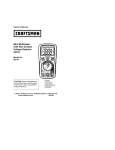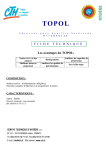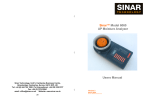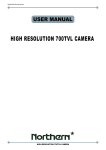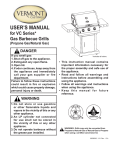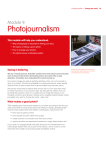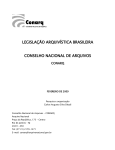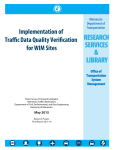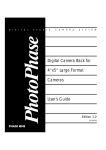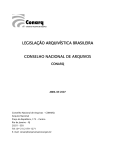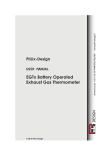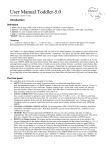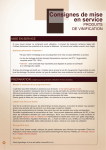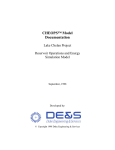Download "user manual"
Transcript
SINAR AP MOISTURE ANALYZER USER MANUAL Read all instructions prior to operating your SinarTM AP Moisture Analyzer. Whenever using this unit, remember to follow the appropriate operating procedures. For your reference/record: Serial Number: Purchase Date: Date Registration Card Mailed: Version 2.0 . ... . 13th May, 1993 Page CONTENTS I INTRODUCTION 1 II BASIC PRINCIPLE OF OPERATION 1 III OPERATING INSTRUCTIONS Measuring % Moisture Content Measuring Sample Temperature Using the ‘Average’ Moisture content facility Measuring Hectolitre (Bushel) Weight Using the Printer 2 111:1 111:2 111:3 111:4 111:5 IV 2 4 5 5 6 CALIBRATION ADJUSTMENTS 10 IV:l % Moisture Content 10 IV:2 Hectolitre (Bushel) Weight 11 VII CALIBRATION TRANSFERS KARDWARE SECTION Set up Checks Changing Default settings Replacement of Batteries Changing the Password Routine Maintenance SPECIFICATION 12 14 14 18 20 20 21 23 VIII MAIN PARTS ILLUSTRATION 25 IX CROSS SECTION OP SAMPLE CELL 26 V VI VI:1 VI:2 VI:3 VI:4 VI:5 APPENDIX I Version 2.0 - Error Code Sunmiary 27 13th May, 1993 The performance of this Moisture Analyzer is dependent on the correct use and instrument care by the customer. It is important to check the calibration (both commodity and hardware) periodically and, if necessary, make adjustments following the procedure in this manual. The commodity calibration can be checked by comparing the Moisture Analyzer results against reference samples, e.g. oven tested samples (please ensure that tested samples are based on the correct oven test specification). If the hectolitre (bushel) weight facility is used, the results should be checked against reference samples and if required the readings can be adjusted following the procedure detailed in this manual. Version 2.0 13th May, 1993 The SinarTM AP Moisture Analyzer houses the latest moisture measuring technology in a compact, portable package. it has been designed to provide fast moisture results using whole grain samples. In addition to % moisture content, the AP measures sample temperature and has facilities for hectolitre (bushel) weight tests. Each instrument is pre—calibrated for up to seven commodities either chosen from a standard package of programmes or selected from Sinar’s calibration library. The calibration of any product can be optimised using a bias facility (moisture and hectolitre (bushel) weight). The SinarTM TM AP Moisture Analyzer is one of a family of 4 Moisture Analyzers. All 4 models have a facility to transfer and receive calibrations from each other. Either new commodities can be transferred or existing calibrations can be updated with new information. II BASIC PRINCIPLE OF OPERATION The design concept of the SinarTM AP Moisture Analyzer is based on the simultaneous sensing of capacitance, weight and temperature of the sample being tested, providing a corrected moisture (%) reading in a few seconds. It works accurately on products with moisture content ranging from approximately 1% to 35% depending on the application. The instrument incorporates 3 sensors: 1. Capacitance The moisture in a sample absorbs the electrical energy between the walls of the sample cell. The electrical signal known as “Capacitance” increases with the moisture content of the sample and the size of the sample. Version 2.0 13th May, 1993 I INTRODUCTION This, oscillating weight balance, which was developed from space technology, uses frequency measurement to determine mass (weight in grams). The weight is measured by reference to a frequency, which varies with mass and is detected through an electro—magnetic system and processed by the computer. This weighing technique offers flexibility in sample size allowing the use of samples between 20 and 240 grams. 3. Temperature Correction The capacitance of a sample increases with temperature. A temperature sensing thermistor is mounted in the sample cell and the microprocessor carries out an automatic correction. The capacitance corrected for weight and temperature is known as the instrument reference reading but in practice it is commonly referred to as the capacitance value. III OPERATING INSTRUCTIONS 111:1 MEASURING % MOISTURE CONTENT a) Place the hopper on the sample cell ensuring the hopper slider is in the closed position. b) Pour the sample into the hopper ensuring the amount used will not exceed level “A” (see Section IX) when the cell is filled. Experience will tell you how much of each product type you need. [See point C) in ‘Notes on Instrument Use’). C) Tap slider upwards to allow the sample to flow through the hole and into the cell. d) Remove hopper. Check that the cell is not overfull. If the sample is heaped on one side, refill sample cell again. Any sample remaining on the cell cap should be brushed off into the sample cell. 1 2.Oscillating Weight Balance e) Switch on Analyzer by pressing f) Press channel number (1—7), e.g. 2 g)Press %H20. Moisture content will be displayed after 5 seconds, e.g. HI 2 — — 14.5 h) Remove the sample cell and empty it. Notes on Instrument Use a) Do not tap or shake the filled sample cell as this will change the packing density. b) If the product does not flow freely through the hopper, then fill the cell by pouring the sample over the cell cap. Do not fill directly into the bottom of the cell. c) A small sample, which does not reach the lower edge of the plastic cell cap, can be used because the weight balance corrects the moisture measurement for the weight of the sample. However, the calibration curve of each product is created with full sample cells as this gives the highest accuracy. d) The flexible temperature sensor below the plastic block in the cell should be in contact with the sample, so that the temperature correction will be accurate. If the sample temperature is very different from ambient, then leave the sample for 30 ‘seconds in the cell before the measurement (or until a stable temperature reading is reached). e) If the sample is too small to reach the sensor then care should be taken that the instrument and sample have approximately the same temperature. f) The minimum weight of sample is 20 grams, below this weight the display will show Err.0 after %H20 is pressed. 2 g) If the sample cell is not correctly mounted, the display will show Err. after %H20 is pressed. If this appears on the display, remount sample cell firmly on to the interface. Switch the Analyzer of f and then on again before proceeding with your work. h) Samples as high as 50°C. can be measured but do not leave the instrument in direct hot sunlight. Clean the sample cell with a soft brush or with a cloth dampened with methanol. NEVER USE WATER! Take care not to damage the flexible temperature sensor. j) If you have more than one Analyzer, do not interchange sample cells. Each Analyzer is individually calibrated with its own sample cell for greater accuracy. Ensure that both the instrument and the sample cell show the same serial number; the serial numbers are located on the bottom of the instrument and on the underside of the sample cell. k) The SinarTM lM AP Moisture Analyzer has been calibrated using clean samples. Accuracy can be affected by the presence of stones, dirt, weeds, seeds, admixture, chaff or other foreign matter. 111:2 MEASURING SAMPLE TEMPERATURE Sample temperature can be measured by pressing TEMP when the sample is in the measuring cell. If the sample temperature is very different from the ambient temperature, leave the sample for 30 seconds in the cell before you press the TEMP key. Alternatively, keep on pressing the TEMP key until a stable temperature is displayed. 3 111.3 USING THE ‘AVERAGE MOISTURE CONTENT’ FACILITY A maximum of 254 samples can be averaged. If the AVER key, is held down, the display will show the number of measurements that have been made, e.g. 3 When this key is released, the average % moisture content will be displayed, e.g. 10.6 The average can be reset to zero by switching the analyzer off and on or by changing channels. 111.4 MEASURING RECTOLITRE (BUSHEL) WEIGHT Th order to use this facility, a SinarTM Th Hectolitre (Bushel) Weight Measuring cylinder is required. This ensures that the correct volume is used. a) Fill the measuring cylinder using the hopper, ensuring the cylinder is over filled. Note: Never pour the grain directly into the cylinder. The rate at which the grain fills the cylinder is critical and the loading hopper must be used at all times. b) Remove the hopper and strike of f the excess sample from the cylinder by closing the metal slider. Pour away the excess sample. c) Open the metal slider and pour the fixed volume of sample using the loading hopper into the Sample Cell. Remove hopper. Any sample remaining on the cell cap should be brushed of f into the sample cell. d) Select channel and press lb/bu kg/hl The hectolitre (bushel) weight reading will be displayed after 5 seconds. * 4 *Note: Always remember to select the correct channel. The hectolitre (bushel) weight readings can be adjusted for individual commodities(Section IV:2) so that they read the same as reference samples. In order to change from hectolitre to bushel weight units and vice versa see Section VI:2 Changing Default Settings. * To repeat the test, repeat steps a) to d). The nature of the operation means that every time lb/bu kg/hi is pressed, the sample packing successive tests on the same sample, it is important to reload the sample first. 111.5 USING THE PRINTER a) Print Format An example of the printer output format is as follows: 5 b) HOW TO START THE PRINTER 1. Connect the Printer Cable to the RS232 Port on the left hand side of the Moisture Analyzer. 2. Connect “D” type connector of the cable to the input of the Serial Printer. 3. Switch on Printer. 4. Switch on Moisture Analyzer. 5. Press and hold CAL display shows AUTO CAL. 6. Press TEMP key, display shows (Means printer on). P on 7. Press CAL display shows — HI — AUTO 8. The printer has now been activated and when %H20 and other measurements are selected the results will be printed. To turn the printer off repeat steps 5 and 6. After step 6 the display shows I ~ — - which means printer off. PLEASE NOTE, THAT IF YOU ARE NOT USING THE PRINTER, ENSURE THAT THE PRINTER SWITCH IS TURNED OFF IN TEE ANALYZER. c) Chancing the Batch Number The batch number is a useful facility when samples need to be recorded: Display Shows 1. 2. Switch on Moisture Analyzer Press and hold ~ AUTO 3. Enter batch number (e.g. 485) — HI CAL. — 4 Press 4 Press 7 47 5 Press 485 A b485 Press 5 HI 4. Press AVER 5. Press CAL AUTO once 48~ d) Changing the Date (day/month/year) 1. Switch on HI 2. Press and hold ~ AUTO 5 3. Press and hold AVER 4. Press AVER — . Enter date ‘(e.g. (30), by pressing 3 followed — CAL. dAtE d ... 30 30/10/92) Enter day by’O fd 30 Press AVER Press AVER again Press 1 [r.~ ... followed byO Press AVER I ~10~ Press AVER again Press 7 H I 6 7 10 • • 1 7 Press A Press AVER Press 2’ twice 92 I 92 omponent of the date can be viewed and corrected by pressing AVER. ‘6.When the date is correct Press~ _HI_ AUTO 7 IV:1 % MOISTURE CONTENT Sometimes it is useful to be able to adjust the moisture reading, (for instance, when a different oven test is used or when the particle size of a product is significantly different or when 2 instruments are checked against each other). However; before adjusting the moisture reading, first check that the hardware settings are correct. (Section VI:l Set-up Checks). The moisture reading may be adjusted for each individual channel by using the up I A and down “ arrow keys. This bias facility is used as follows: 1. Determine the average adjustment needed. Compare at least 3 different samples. Display Shows * 2. Switch on 3. Press and hold ~ AUTO 4. Enter Password* and press P CAL. The Analyzer “rings” if the wrong password is entered. 5. a) Fill measuring cell with sample. b) Select channel. c) Press %H2O. After 5 seconds the moisture result is displayed. If the average adjustment needed is +0.3% press A arrow three times so that the display reads: 6. I_HI_I Press and hold ib/bu and this displays the 9, I’ 10.91 II 11.2 IV CALIBRATION ADJUSTMENTS kg/hi channel number that has been adjusted. Release the key and the display will show the adjustment that has been made. 10 CALIBRATION ADJUSTMENTS IV * Note’: When the instrument leaves the factory the password is 123. However this can be changed as explained in Section Vi:4. In order to check to see whether a channel ha,s been adjusted, proceed as follows: Display Shows, IV: 2 1. Switch on IC 0.0 2. Press and hold ~ AUTO 3. Select channel, e.g. Number 1 4. Press ib/bu kg/hi (0.0 means that no adjustment has been made). HECTOLITRE (BUSHEL) WEIGHT CAL. In the same way as moisture readings can be matched to oven test results or some other test, e.g. merchants moisture analyzer; the hectolitre (bushel) weight results can also be adjusted to read the same as another instrument. As for the moisture adjustment, it is important that the set-up checks are correct, particularly the Weight Balance, before any hectolitre (bushel) weight comparisons and any subsequent adjustments are made. The procedure to adjust the hectolitre (bushel) weight readings is as follows: Display Shows 1. Switch on 10 CALIBRATION ADJUSTMENTS IV 2. Select channel No. (1—7) e.g. 1 Jr 3. Press and hold P. HI 1 11 CALJ CALIBRATION ADJUSTMENTS IV I 4. Use the arrow keys to make the 0.5 adjustment necessary for the particular product, e.g. if readings are to be increased by 0.5kg/hi, press A 5 times. 5. Press CAL I End AUTO The adjustment is now complete. In order to. see whether a channel has been adjusted, proceed as follows: Display Shows I 1. Switch on 2. Select channel No. (1—7) e.g. 3. Press and hold P. 4. Press P — HI — I I i CAL I I 0.5 (Shows that readings have been increased by 0.5). Note: Please be aware of the effect of moisture content on hectolitre (bushel) weight, i.e. above 15% as moisture content increases the hectolitre (bushel) weight decreases. For this reason it is best to base any adjustment on tests which have been made using samples which have a moisture content of approximately 15%. V CALIBRATION TRANSFERS The SinarTM T~~ AP Moisture Analyzer can be used to send and receive calibrations from other SinarTM TM Moisture Analyzers. This facility is extremely useful for updating calibrations and also for providing a calibration for testing a new commodity. The following instructions relate to communicating with other AP Analyzers only. Details of communications with 11 IV CALIBRATION ADJUSTMENTS other models are included in their manuals. 12 respective user CALIBRATION ADJUSTMENTS IV In order to transfer one calibration to an AP analyzer, proceed as follows: Display Shows 1. Ensure both units are switched of f 2. Connect the calibration transfer cable to the P2232 port on the left hand side of the Moisture. Analyzers. 3.. Switch 5. Enter 6. Press ~ I_HI_ i on both units. For both instruments: 4. Hold down ~ AUTO Password and press P 1 CAL. AUTO 1J By this stage both units should be displaying CO.PA (This is known as the communication mode) I ‘I 1I CO.PA Out On the Sending Unit 7. Pres.s Channel number e.g. 1 (This contains the calibration curve to be transferred to the other AP Analyzer). 8. Press’ %U20. _________ I ‘ “~‘ I On the Receiving Unit 9. Pres.s Channel number, calibration is to be installed. eg 7 in which new 10. Press AVER On the Sending Unit: On the Receiving Unit: 12 Jo I’ I CALIBRATION ADJUSTMENTS IV After 6 seconds both units will display The transfer is now complete. units and remove cable. To transfer all 7 calibrations, to another AP Moisture Analyzer. When the transfer is completed both units will display Both units displaying 1. 2. On the sending unit press %H20 On the receiving unit press AVER Sending unit changes to VI HARDWARE SECTION VI:l SET UP CHECKS PASS I Switch off both CO.PA Out In~ Out. I Receiving unit changes to in. PASS To check that the instrument is in good working order the three sensors, i.e. Temperature, Weight and Capacitance should be checked as follows: Temperature Pour the sample into the cell and leave for 30 seconds so 13 IV CALIBRATION ADJUSTMENTS that the sample and cell temperature are in equilibrium. Check temperature of grain using an accurate thermometer. Switch on instrument and press TEMP. The two readings should not differ by more than 1.5°C. 14 CALIBRATION ADJUSTMENTS IV The weight balance is checked using a sample that weighs 180 grams. Any 180g sample should read 64.5 kg/hI ±1.0 when lb/bu is pressed, kg/hi i.e. between 63.5 and 65.5. ‘The weight balance should be reset if 180 g weighs less than 63.5 kg/hi or greater than 65.5 kg/hi. Capacitance This is checked using .a capacitance reference sample. With the sample in the cell press 0 and then press %H20. The result should be no greater than ± 0.6 from the value of the capacitance reference sample. If any of these measurements are out of tolerance, the instrument should be reset. As a daily check. the Q~ key can be used to AUTO c’heck that the instrument is set up correctly when the sample cell is empty. The procedure is as follows: Display Shows 1. Switch on.. 2. Press CAL’ AUTO After 5 seconds _ HI I — 1 AUTO A 000 This indicates that for the empty sample cell test, the weight and capacitance are within the limits. The first two zeros are capacitance checks. The third 0 is’ the chec’k of the empty cell weight. NB. If the display shows anything other than instrument needs to be reset. 14 f A 000 then the Weight a) Procedure for Resetting Hardware Ensure cell is empty and hopper removed. - Display Shows HI — 1. Switch on. 2. Press and hold ~ 3. Enter password andpressP — CAL. AUTO I Press and hold ~ AUTO 5.Press and hold AVER until analyzer bleeps. I ~ 4. H.CAL I 1= ‘I .______ lj 6. Fill the cell with a 180 gram capacitance reference sample (eq 28.1) Allow 1 minute for the cell and sample temperature to equalise. 7. Enter Reference Value (eg 28.1) Press 2 I 2J Press 7 Press A once I I 28 Press 1 I 281 I Press lb/bu kg/hi 15 28.1 I Weight 8. Enter Temperature Insert thermometer probe into grain and note reading, (eq 21.0°C) Press 2 2 Press 1 21 Pres’s 0 210 Press. TEMP 21.0 Press and hold %E20 until analyzer 2 bleeps. 2 2 9. This completes the hardware resetting. Now check the temperature., weight and capacitance. b) Resetting the Weight Balance Only As. the only moving part in the instrument, the weight balance generally needs resetting more often than the other 2 sensors. For this reason there is .a quick procedure to reset the weight balance only. Ensure the cell is empty and hopper removed. Display Shows 1. Switch on. 2.. — I — Press and hold CAL AUTO 3. HI L 1 Enter password and press P 16 ‘CAL. ~ Weight 4. Press and hold ~L AUTO 5.Press 0 and press and hold P until analyzer bleeps. H. CAL I I 1= 11 ° - 11 6, Add a 180 gram sample to the cell. Press 1 and press and hold P bleeps. 1 until analyzer 2J 21 This completes the resetting of the weight balance only. Switch analyzer off and on, reload the 180 gram sample and and check the ib/bu reading to ensure it is 64.5 ±1 kg/hl. kg/hi VI:2 CHANGING DEFAULT SETTINGS The following options are available: a) Hectolitre or bushel weight readings. b) Temperature °C or °F. C) Baud rate setting of 300 or 4800. d) High or low frequency moisture measurement. - The procedure to change from one default setting to the other is as follows: Display Shows 1. Switch on. 2. Press and hold ~ AUTO — HI 3. Enter password and press P P 17 — CAL. Weight 4. Press CAL AUTO 5. Press CAL again AUTO CO.PA I In — this mode the TEMP SEt 1 following keys have specific functions: When thi.s key i.s hel.d down, the display changes from USA to Euro or vice versa. In Euro units the readings are °C for temperature and kg/hi for specific weight i.e. hectolitre weight. In USA units, the readings are °F for temperature and lb/bu for specific weight, i.e. bushel weight. AVER When this key i.s held down the baud rate changes from 300 to 4800 or vice versa. - — When this key is held down, the analyzer changes from high to low frequency measurements or vice versa. It is always possible to say what frequency is %H20 being used as soon as the analyzer in switched on: I_HI_ I Iii i~ I - - Low Frequency High Frequency High frequency moisture measurements improve the performance of the analyzer at higher moisture values, e.g. 20%+ for cereals. Please be aware that unless specifically requested all SINARTM Th calibrations are designated for low frequency testing. When this key is held down the lb/b u kg/h i display changes from nor to l8Or or vice versa. When 180r is displayed, this fixes the sample weight that will be used in the moisture calculation. 18 Weight Battery Low The alkaline batteries in your Moisture Analyzer should last for at least 8,000 readings or one years regular use. Battery Low Indicator Should the batteries begin to fail, a warning signal will appear when the instrument is switched on: I bittseconds. will continue to flash on and off for a few To Replace the Batteries 1. Remove the sample cell from the instrument. 2. Unscrew the battery cover from the underside of the instrument. 3. Remove the old batteries and replace with four standard l.5v alkaline batteries (Size C, MN 1400 or equivalent). BE SURE TO INSERT BATTERIES THE CORRECT WAY ROUND AS MARKED IN THE BATTERY COMPARTMENT. 4. Replace the battery cover. Important! Always use alkaline batteries for longer life and better storage. If you are not going to use the moisture analyzer for some time, remove the batteries from the instrument. VI:4 CHANGING THE PASSWORD The password can be changed to prevent unauthorised changes being made to the instrument. When the instrument leaves the factory the password is 123. 19 VI.3 REPLACEMENT OF BATTERIES Display Shows 1. Switch on. I 2. Press’ and hold Q~ C O . P A AUTO 3. Enter password 123 and press P 4. Press’ and hold Q~ AUTO I 5.. Press ~ again AUTO 6. Enter new password, 3 digits of your choice (if necessary use arrows, i.e. if you want’ to use 8 or 9 in the password). 7. Press ib/bu. (enters new password kg/hi into memory). 8. Switch off and on Check new password I_~_I x~z I! P x Y z I CAL. I I H.CAL Write down new password in appropriate place and make known to. authorised personnel only. If the wrong pas’sword is entered the analyzer will ‘ring’; try entering the correct password again. 20 It can be changed as follows: VI: 5 ROUTINE MAINTENANCE it is. important that on a monthly basis, (or more frequent depending on the operating environment) the male and female interfaces are cleaned with Methanol or a similar solvent, using a piece of kitchen towel or other soft material. (The female interface is located, on the underside of the cell) Blow away any dust from the seal around the male interface. 21 It can be changed as follows: If you have more than one Analyzer be sure to use each sample cell only with the instrument with which it was supplied. Each Analyzer is individually calibrated with its own sample cell. Ensure that both the instrument and the sample cell display the same serial number; the serial numbers are located on the bottom of the instrument and on the underside of the sample cell. 21 b)Serial Number Dimensions 325mm x 164mm x 120mm. Weight 1.8kg. Operating Environment Temperature 0 to +55 deg °C. Storage Temperature -20 deg C to +55 deg C; Humidity up to 95% non condensing. Construction Polyurethane Reaction Injection Moulding. Display 3.5 character. LCD 15mm high. Power Supply Four C size 1.5 volt alkaline batteries. Processor Intel 80C3l microprocessor. Memory EPROM and. RAN. Measurement Range 1 35% moisture, wet basis depending on applications. — Printer Output RS232. ‘C. Accuracy Typical standard deviation 0.3 for moisture (dependent on application and moisture level) and 1.0 for hectolitre (bushel)’ weight. Repeatability Standard deviation 0.05 to ‘0.15 (dependent on application). Weight Balance Oscillating weight balance which also operates in nonhorizontal po.sition. Measures and corrects for weights. be.tween 20-240 grams. Temperature Correction Thermistor sensor connected to microprocessor. The c’orrection is software programmable. Temperature rea.d out and c’orrection 0—50 deg C. 22 VII TE~MNI~AL SPECIFICATION Full Cell 290m1 volume. Bias Facility Moisture content and hectolitre (bushel) weight readings can be biased in increments of 0.1. Temperature °C or °F - Specific Weight Hectolitre or Bushel weight readings. 23 VII TE~MNI~AL SPECIFICATION MAIN PARTS ILLUSTRATION VIII A S C O J”IOPPER. HOPPER SLIDE SENSOR BLOCK, TEMPERATURE SAMPLE. CEL E SAMFLE CELL MOUNTING ON WEIGHT BALANCE F c 3 H WEIGHT BALANCE COVE 24 VII TE~MNI~AL SPECIFICATION DIGITAL DISPLAY K’ E YB. 25 VII TE~MNI~AL SPECIFICATION \ \fl —~_..TEMP SENSOR V C CELL CAP -For optimum reading the cell should be filled to level “A” (bottom of the plastic cell cap). -The sample should not cover the plastic cell cap or inaccuracies will be introduced. -Smaller samples are allowed and give slightly lower accuracy. -The minimum sample is 20 g. 25 Ix CROSS SECTION OP SAMPLE CELL ERROR CODE SUMMARY Error n Code Explanat ion : d Recomme e Act d ion Err.0 than 20g) Remount sample Err. 1 Sample. weight too low cell firmly on to Sample cell mounted not correctly the interface Use larger sample (greater Err. 5 changing ‘byte down capacitance 28 Err.2 Capacitance reading is too high (‘over 100) Check hardware If necessary, scale by Err.3 Capacitance too high at reading is low moisture Chec.k hardware If necessary, scale Check cabl,e and. by ch’anging byte 28 down capacitanc e 26 start again Replace the batteries APPENDIX I .Err.4High moisture reading at low capacitance reading batt indicator Check hardware If necessary, this can be rectified by shifting the calibration Capacitance reading is too low for t’he calibration curve. (i.e. %M..C. would be negative) Err..6 Battery low ‘Check hardware Check calibration. curve CommuniHcation, error in RS232 27







































